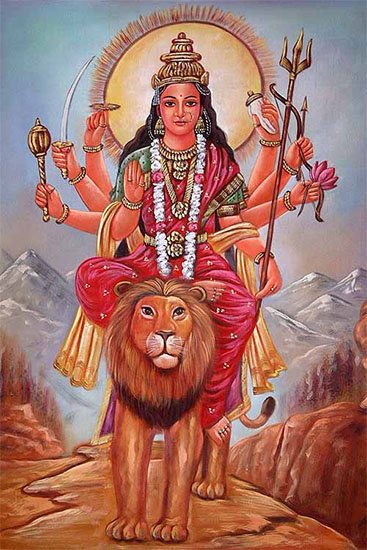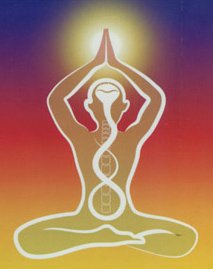Trisha, Tṛṣā: 16 definitions
Introduction:
Trisha means something in Hinduism, Sanskrit, Jainism, Prakrit, Marathi, Hindi. If you want to know the exact meaning, history, etymology or English translation of this term then check out the descriptions on this page. Add your comment or reference to a book if you want to contribute to this summary article.
The Sanskrit term Tṛṣā can be transliterated into English as Trsa or Trisha, using the IAST transliteration scheme (?).
Alternative spellings of this word include Trasha.
In Hinduism
Shaktism (Shakta philosophy)
Source: Wisdom Library: ŚāktismTṛṣā (तृषा, “Thirst”):—One of the names of Mahākālī (tamas-form of Mahādevī). Mahākālī is one of the three primary forms of Devī. Not to be confused with Kālī, she is a more powerful cosmic aspect (vyaṣṭi) of Devi and represents the guṇa (universal energy) named tamas. For reference, see the Devī Māhātmya, a Sanskrit work from the 5th century, incorporated into the Mārkaṇḍeya-Purāṇa.

Shakta (शाक्त, śākta) or Shaktism (śāktism) represents a tradition of Hinduism where the Goddess (Devi) is revered and worshipped. Shakta literature includes a range of scriptures, including various Agamas and Tantras, although its roots may be traced back to the Vedas.
Yoga (school of philosophy)
Source: ORA: Amanaska (king of all yogas): A Critical Edition and Annotated Translation by Jason BirchTṛṣā (तृषा) refers to “thirst”, according to the Amṛtasiddhi (verse 24.1-2).—Accordingly, [while describing kāyasiddhi in terms redolent of tapas (i.e., purification and bindu):] “When the accomplishment of [destroying] the [five] impurities [is achieved], as well as the union of the two Bindus, then one should know the body to be perfected and endowed with all good qualities. [Such a Siddha] is free from cold, heat, thirst (tṛṣā), fear, desire and greed. He has crossed over the ocean of anxiety, disease, fever, suffering and grief”.

Yoga is originally considered a branch of Hindu philosophy (astika), but both ancient and modern Yoga combine the physical, mental and spiritual. Yoga teaches various physical techniques also known as āsanas (postures), used for various purposes (eg., meditation, contemplation, relaxation).
In Jainism
General definition (in Jainism)
Source: archive.org: TrisastisalakapurusacaritraTṛṣa (तृष, “thirst”) refers to one of the hardships (parīṣaha), or “series of trials hard to endure” according to the Triṣaṣṭiśalākāpuruṣacaritra 10.1 (Incarnation as Nandana). While practicing penance for a lac of years, Muni Nandana also endured a series of trials hard to endure (e.g., tṛṣa). Nandana is the name of a king as well as one of Mahāvīra’s previous births.
Source: academia.edu: Tessitori Collection ITṛṣā (तृषा, “thirst”) refers to one of the various “sufferings inherent to the hells (naraka)”, according to Rājasoma’s “Naraka ko coḍhālyo”, which is included in the collection of manuscripts at the ‘Vincenzo Joppi’ library, collected by Luigi Pio Tessitori during his visit to Rajasthan between 1914 and 1919.—No name of any source is given in the text but the three stages followed in the exposition correspond closely to those found in a handbook such as Nemicandrasūri’s Pravacanasāroddhāra, [e.g.,] 1) sufferings inherent to the hells (up to 2r): heat (uṣṇa), cold (sīta), hunger (kṣudhā), thirst (tṛṣā), itching caused by knives (churī), bad smell, internal burning, fear of coming dangers known through avadhi or vibhaṅga knowledges, sorrow.

Jainism is an Indian religion of Dharma whose doctrine revolves around harmlessness (ahimsa) towards every living being. The two major branches (Digambara and Svetambara) of Jainism stimulate self-control (or, shramana, ‘self-reliance’) and spiritual development through a path of peace for the soul to progess to the ultimate goal.
Languages of India and abroad
Marathi-English dictionary
Source: DDSA: The Molesworth Marathi and English Dictionarytṛṣā (तृषा).—f (S) tṛṣṇā f S Thirst, lit. fig. ambition, cupidity &c. tṛṣākula, tṛṣākrānta, tṛṣātura, tṛṣānvita, tṛṣāpīḍita, tṛṣārtta &c. Pained with thirst.
Source: DDSA: The Aryabhusan school dictionary, Marathi-Englishtṛṣā (तृषा).—f Thirst. Fig. Ambition. Cupidity.
Marathi is an Indo-European language having over 70 million native speakers people in (predominantly) Maharashtra India. Marathi, like many other Indo-Aryan languages, evolved from early forms of Prakrit, which itself is a subset of Sanskrit, one of the most ancient languages of the world.
Sanskrit dictionary
Source: DDSA: The practical Sanskrit-English dictionaryTṛṣā (तृषा).—See तृष् (tṛṣ).
Source: Cologne Digital Sanskrit Dictionaries: Shabda-Sagara Sanskrit-English DictionaryTṛṣā (तृषा).—f.
(-ṣā) Thirst. 2. Wish, desire. 3. The daughter of Kama: see the preceding. 4. A plant, (Commelina salicifolia:) see lāṅgalikī. E. tṛṣ to thirst, affixes ka and ṭāp; also tṛṣṇā, tarṣā, &c.
Source: Cologne Digital Sanskrit Dictionaries: Benfey Sanskrit-English DictionaryTṛṣā (तृषा).—[tṛṣ + ā], f. 1. Thirst, [Pañcatantra] 81, 22. 2. Desire, [Hitopadeśa] i. [distich] 133.
Source: Cologne Digital Sanskrit Dictionaries: Cappeller Sanskrit-English DictionaryTṛṣā (तृषा).—[feminine] the same.
Source: Cologne Digital Sanskrit Dictionaries: Monier-Williams Sanskrit-English Dictionary1) Tṛṣā (तृषा):—[from tṛṣ] f. thirst, [Nalopākhyāna ix, 27; Suśruta; Vetāla-pañcaviṃśatikā] etc.
2) [v.s. ...] strong desire, [Hitopadeśa i, 6, 34]
3) [v.s. ...] Desire as daughter of Love, [cf. Lexicographers, esp. such as amarasiṃha, halāyudha, hemacandra, etc.]
4) [v.s. ...] Methonica superba, [cf. Lexicographers, esp. such as amarasiṃha, halāyudha, hemacandra, etc.]
Source: Cologne Digital Sanskrit Dictionaries: Yates Sanskrit-English DictionaryTṛṣā (तृषा):—(ṣā) 1. f. Idem.
Source: DDSA: Paia-sadda-mahannavo; a comprehensive Prakrit Hindi dictionary (S)Tṛṣā (तृषा) in the Sanskrit language is related to the Prakrit word: Tisā.
[Sanskrit to German]
Sanskrit, also spelled संस्कृतम् (saṃskṛtam), is an ancient language of India commonly seen as the grandmother of the Indo-European language family (even English!). Closely allied with Prakrit and Pali, Sanskrit is more exhaustive in both grammar and terms and has the most extensive collection of literature in the world, greatly surpassing its sister-languages Greek and Latin.
Hindi dictionary
Source: DDSA: A practical Hindi-English dictionaryTṛṣā (तृषा) [Also spelled trasha]:—(nf) thirst; ~[lu] thirsty.
...
See also (Relevant definitions)
Starts with (+71): Tisarana, Trisahasra, Trisama, Trisanu, Trisapta, Trisara, Trisashta, Trishabhu, Trishadhastha, Trishaha, Trishakala, Trishakha, Trishakhabrahmana, Trishakhapatra, Trishakhapattra, Trishakti, Trishaktipaddhati, Trishaktistotra, Trishaktitantra, Trishakula.
Ends with: Atrisha, Kshuttrisha, Maitrisha, Mitrisha, Mrigatrisha, Ratrisha, Satrisha, Surastrisha, Vitrisha.
Full-text (+13): Trishabhu, Trishaha, Mrigatrisha, Trisharoga, Trisharta, Trish, Trasha, Trishenem, Trishanem, Trishartta, Mrigatrish, Vitrisha, Tisa, Trishita, Talu, Vyakosha, Bandavadi, Trishna, Gokula, Parishushka.
Relevant text
Search found 14 books and stories containing Trisha, Tṛṣā, Trsa; (plurals include: Trishas, Tṛṣās, Trsas). You can also click to the full overview containing English textual excerpts. Below are direct links for the most relevant articles:
Tattvartha Sutra (with commentary) (by Vijay K. Jain)
Verse 9.16 - The afflictions caused by the feeling karmas < [Chapter 9 - Stoppage and Shedding of Karmas]
Verse 9.10 - Fourteen afflictions are possible in stages 10-12 < [Chapter 9 - Stoppage and Shedding of Karmas]
Verse 9.9 - The twenty-two kinds of afflications (parīṣaha) < [Chapter 9 - Stoppage and Shedding of Karmas]
Garga Samhita (English) (by Danavir Goswami)
Verse 2.20.24 < [Chapter 20 - The Rāsa-dance Pastime]
Verse 2.20.23 < [Chapter 20 - The Rāsa-dance Pastime]
Chaitanya Bhagavata (by Bhumipati Dāsa)
Verse 1.6.105 < [Chapter 6 - The Lord Begins Studying and His Childhood Mischief]
Trishashti Shalaka Purusha Caritra (by Helen M. Johnson)
Tattva 6: Saṃvara (methods of impeding karma) < [Appendix 1.4: The nine tattvas]
Sahitya-kaumudi by Baladeva Vidyabhushana (by Gaurapada Dāsa)
Text 10.67 < [Chapter 10 - Ornaments of Meaning]
The Buddhist Path to Enlightenment (study) (by Dr Kala Acharya)
The twenty-six Parīṣahas (endurance of hardships) < [Chapter 4 - Comparative Study of Liberation in Jainism and Buddhism]